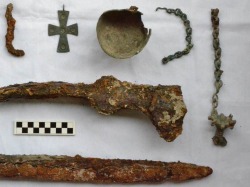History Professor Excavates the Byzantine Past in Central Turkey

Dr. Marica Cassis has been awarded a five-year SSHRC Insight grant ($370,062) for the Byzantine excavations at the site of Çadır Höyük (“Tent” Mound) in Yozgat Province. The site, which includes a large farmhouse/village complex as well as a major fortification, provides important data about a population and a region we know little about in the Byzantine period. The Byzantine excavations are done under the auspices of the wider Çadır Höyük excavations, which are directed by Dr. Gregory McMahon (University of New Hampshire) and Dr. Sharon Steadman (SUNY Cortland), who are collaborators on this grant.
These artifacts (see photo at right) represent the types of objects used by the Byzantine population at Çadır Höyük. There are some functional objects (an axe, a sword) and some small religious artifacts (such as the cross, a possible incense burner); both types of artifacts represent the very practical lives lived at a site such as ours. Although Byzantium is often represented in textbooks through images of royalty and urbanization, we tend to forget that the Byzantine Empire also included very ordinary people leading very ordinary lives.
The focus of the research is to clarify and further understand the history of the Byzantine occupation of the site, and relate the material to other agricultural sites in the region in order to understand both how they functioned and how they were connected to one another. This region is particularly important in Byzantine period because it was on the frontlines of Christian/Muslim interaction, and provides an important case study for understanding how the region changed as the Byzantine Empire disintegrated in the face of the arriving Seljuk armies.